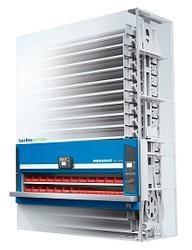
A look back in time – The vertical carousel through the years
First introduced in the 1950’s the vertical carousel is probably the most well known automated storage and retrieval system. Some critics might say the vertical carousel is “old” or “outdated”, but that’s simply not true. Besides, don’t most things get better with age? Like a fine wine that gets better each year, so does the vertical carousel. The vertical carousel on the market today is not the same vertical carousel that was introduced over 60 years ago. Although the basic concept remains the same; a motor drives a number of carriers attached to a chain around like a ferris wheel to deliver the desired product to the operator at an access opening; many improvements have been made to improve efficiency and overall usability of the vertical carousel. Not only has it become more efficient; but it also boasts greater storage flexibility, safety advancements, security improvements and software integration just to name a few.
Advancements In Efficiency & Usability The vertical carousel has been reengineered countless times gaining efficiency improvements every time. Applying cutting edge engineering and technology to a trusted design the vertical carousel now requires less energy to operate and has a lighter unit weight, all while maintaining the highest MTBF (Mean Time Between Failure) rate than most household appliances. To further increase reliability, most vertical carousels come standard with a hand crank, allowing 24-7 access to stored goods even without power. A variety of carriers are available that provide storage flexibility. Standard shelf carriers can be sub divided to maximize storage density. Rollout drawers can be installed to hold small parts. Numerous specialty inserts can store anything from heavy tools and dies to sensitive electronic components. Carriers can be designed around the items being stored, and easily changed or modified in the future. Worker safety has also improved greatly. Vertical carousels come standard with safety lights located at pinch points. While the carousel is in motion, if the light barrier is interrupted the carousel automatically stops to prevent operator injury. Vertical carousels can also be equipped with multiple access openings allowing workers to store items using one access point and retrieve items from another access point. This allows items to be easily stored on one floor and retrieved on another floor without having to carry the items up stairs or transport items using a cart/elevator, putting worker safety at risk.
Product security has been enhanced through the use of automated doors, allowing highly valuable products to be stored securely within the vertical carousel. The security doors remain closed while the carousel rotates to the desired location, preventing the operator from reaching in and accessing other stored items as they pass by the access opening. The automated security door only opens after the carousel has arrived at the desired carrier, allowing the operator access to only the stored items on that specific carrier. The most impressive advancement in vertical carousel technology comes with software integration. The integration of inventory management software allows features such as inventory tracking, barcode scanning and pick to light technology making the vertical carousel even smarter. Inventory management software also provides dynamic space management to increase the storage density within the unit.
In addition to software advances comes advances in pick to light technology. Vertical carousel pick to light technology has evolved from a single illuminated LED used to direct the operator to the item to be picked. Today’s vertical carousels offer complete message centers that direct the worker to the location of the item to be picked, display the part number or description, pinpoint the exact compartment and whether to pick or store, and what quantity. www.KardexRemstar.com









